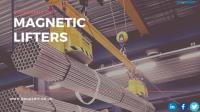 Add My Company
Add My Company
Sign In
Magnetic Lifters: All You Need to Know
26-04-2018

Magnetic Lifters
Over the last few years magnetic lifters have grown in popularity, especially in the recycling, metalworking, mining, construction and demolition industries. Today, magnetic lifters prove the most convenient tool for moving substantial, ferrous loads. This is mainly due to the strength they offer. With a simple flip of a switch, the smallest of boxes can easily move tons of weight.
How do they work?
Most magnetic lifters consist of a slightly different design; however, the general concept remains the same. Each magnetic lifter contains a metal cylinder which houses neodymium magnets, wrapped in an electric coil. When in operation, the coil is charged with a burst of electricity, producing an attractive field.
The magnetic field generated by the coil realigns the atoms in the metal cylinder. However, before operation, the atoms in the cylinder are randomly arranged. Once produced, the electrical current creates a uniformly aligned domain in the metal, which in turn amplifies the attractive field. It is the tightness of the coil and the material used in the metal cylinder, that are primarily responsible for the device’s working power. Therefore, by scaling both of these up, industrial lifting magnets are able to produce their impressive grabbing ability.
Once the atoms in the metal are completely aligned, increasing the electrical current won’t increase the attractive force. Therefore, most magnetic lifters are designed so that it’s impossible to power the device beyond saturation.
When turned off these magnets face back into the lifter, while the cylinder and lifter absorb much of the magnetic field. When the lifter is turned on, the cylinder is turned upside down, exposing the magnets to the area underneath the lifter. Therefore, allowing them to attract heavy objects.
Powerful magnetic lifters can carry all sorts of ferromagnetic materials, including:
Heavy metal sheets
Beams
In some cases, magnetic lifters even have a small groove cut underneath to help grab onto metal pipes.
Factors influencing lifting capacity
There are a couple of factors that influence the magnets lifting capacity:
Surface condition: Magnetic force can pass easily through iron, but not air. Therefore, anything that creates an air gap between the magnet and the lifted object will have a negative impact on the magnets lifting capacity. This includes dirt, moisture, paper, paint or rust.
Temperature: The higher the temperature the lower lifting capacity.
Safety practices
When working with magnetic lifters, the safety practices are the same as those when working with regular magnets. However, since working with loads in the air, everyone in the vicinity should wear hard hats. It goes without saying that those with pacemakers or defibrillators must keep away, while others must keep their hands away from the lifter when it’s on.
Other general safety procedures include:
Read and understood the instructions before operating the magnetic lifter
Remove magnet from service if capacity or safety-first tags are missing
Exercise caution when handling iron or steel materials near magnets
Workers should never stand below a lifting magnet
Special precautions
As mentioned, magnetic lifters use powerful neodymium magnets. Although, they are vulnerable to damage from heat, so they need to be located in a temperature-controlled environment. As a rule of thumb, the number to keep in mind is 80°C. At this temperature, neodymium magnets will begin to decline in strength, meaning if exposed to this temperature long enough they’ll permanently lose their magnetism.
It’s important to keep magnetic lifters and the materials away from any debris. When in use, the significant amount of force pulls the lifter and the ferromagnetic material together, so anything in between may potentially be crushed, cut into the lifter, or burst and kick out into the open, creating a safety hazard.
Important considerations
If taking note of the stats on each lifter, there are three important numbers to look out for:
The rated capacity: This is the maximum working weight for non-cylindrical objects, such as sheets of metal.
The cylindrical capacity: This is the maximum working weight for cylindrical objects, like pipes.
The max tear-off strength: This refers to the total weight required to pull an attached item away from the lifter.
For more information on magnetic lifters contact:
Peter Buckley
T: +44 (0)7482983183
E: pbu@goudsmit.eu
Follow us on LinkedIn, Twitter and Facebook for regular updates.
For more information on Magnetic Lifters: All You Need to Know talk to Goudsmit Magnetics (UK) Ltd
Enquire Now
List your company on FindTheNeedle.

